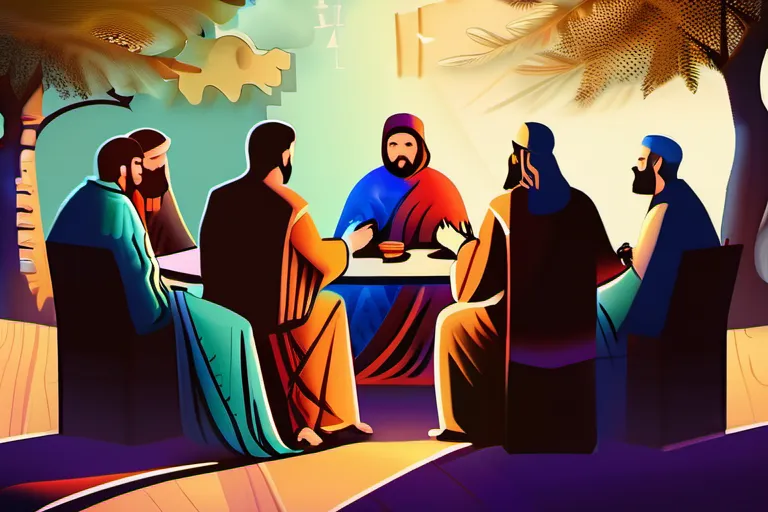Explore the key beliefs and doctrines that define Arian Christianity
Arian Christianity, a significant branch of early Christian thought, was named after Arius, a priest who lived in Alexandria during the 3rd century. This article delves into the central principles that defined this influential movement.
The Life and Teachings of Arius
Imagine stepping into a world where ancient beliefs about God’s nature were being fiercely debated, and one man’s radical ideas shook the foundations of early Christianity. This is the story of Arius, whose teachings ignited a theological firestorm that would define Arian Christianity for centuries.
Arius, born in Alexandria around 250 AD, was more than just a theologian; he was a spark, igniting discussions and controversies that continue to resonate even today. His life, though brief by modern standards, had an enduring impact on Christian doctrine. What made Arius so compelling? It was his unwavering belief in the divinity of Jesus Christ, but with a twist: he argued that while Christ was divine, He was not co-eternal or co-equal with God the Father.
Imagine for a moment, Arius challenging the prevailing orthodoxy. How could a simple priest’s words stir such profound debate? The crux of his argument lay in his understanding of Jesus as the firstborn among many brethren, emphasizing that Christ was a created being, not part of the eternal Trinity.
This belief, while revolutionary at the time, has echoes in contemporary discussions about the nature of divinity and creation. Arius saw God’s Word, His Son, as a powerful agent of creation but not co-eternal with Him. This perspective was met with resistance, even from within his own church. The debate raged on, with supporters and opponents clashing over the very nature of faith.
Arius’ teachings were so influential that they reached the highest echelons of Christian leadership. Emperor Constantine himself was drawn into the fray, convening the Council of Nicaea in 325 AD to settle this theological dispute once and for all. The outcome defined Arian Christianity as a heretical sect by the standards set at that council.
While Arius is no longer widely discussed in mainstream Christian circles, his legacy endures through the debates he sparked. His life serves as a reminder of how deeply entrenched our beliefs are and how much can change when we question them. Arius’ teachings challenge us to think critically about the nature of God and our understanding of faith.
The Trinity Debate: The Heart of Arianism
The Trinity Debate: The Heart of Arianism
Imagine a garden where every flower represents a belief about God. In this vibrant landscape, Arian Christianity emerges as a unique bloom, distinct from the mainstream garden that we know today as orthodox Christianity. At its core, what made Arius’s teachings so compelling and controversial was his stance on the nature of the Holy Trinity: specifically, the relationship between the Father, Son, and Holy Spirit.
How could it be that one group believed in a single God who manifested himself in three persons? Wasn’t the idea of a trinity an abstract concept too complex for human understanding? Arius suggested that the Son, Jesus Christ, was not co-eternal with the Father but had a distinct and hierarchical role. This belief led him to argue that the Son was created by God, thus giving rise to his name: Arianism.
The question of whether Jesus was fully divine or simply a great prophet sparked intense debate. Arius proposed that if the Father is uncreated and eternal, then the Son must have been created at some point. This idea painted a picture of two different beings, rather than three persons in one Godhead. The metaphor of a tree, with its roots deeply entrenched in the earth (the Father) and its branches reaching towards the sky (Jesus), became a powerful symbol for Arians, highlighting the clear distinction between the Creator and His creation.
But what if this distinction blurred the unity of God? How could one be both created and uncreated simultaneously? These questions reverberated through churches, councils, and theological debates. The heart of Arianism lay in its challenge to the established Christian understanding of the Trinity, a concept that seemed too close to heresy for comfort.
The Council of Nicaea and the Definition of Orthodoxy
The Council of Nicaea, held in 325 AD, was like a grand judicial arena where the fate of Arian Christianity hung in the balance. Imagine the bishops and theologians gathering to define what it meant to be orthodox. The stakes were incredibly high—were they to accept Arius’s teachings or uphold the traditional Christian belief?
The council was convened by Emperor Constantine, who saw an opportunity to unite the empire under a common faith. But the debate was fierce and polarizing. Arius proposed that Jesus Christ, while divine, was not of the same substance as God the Father—a concept that threatened the core beliefs of Christianity.
It’s almost like playing a game where everyone agrees on the rules until someone suggests changing one piece. Suddenly, the whole structure starts to wobble. The council had to decide: could Arius remain part of their faith community, or was he pushing them too far?
The outcome was decisive. The Nicene Creed was drafted, stating that Christ was “of one substance with the Father.” This was a direct challenge to Arianism’s doctrine, marking a turning point in Christian history. The council effectively defined orthodoxy and condemned Arius as a heretic.
But what did this mean for those who believed in Arian Christianity? It meant they were now seen as outsiders, their beliefs considered invalid by the majority of the Church. Yet, Arianism lived on, like a stubborn flame that refuses to be extinguished, spreading its teachings through various regions and even influencing some non-Christian philosophers.
The impact of the Council of Nicaea was profound. It set the stage for centuries of theological debate and conflict within Christianity. The doctrines established at Nicaea became central to what is now considered mainstream Christian theology, shaping the identity and beliefs of millions around the world.
Key Figures in Arian Christianity
Understanding the Central Principles of Arian Christianity involves delving into a complex and often misunderstood theological perspective that emerged early in Christian history. The core belief of Arian Christians challenges the orthodox view by questioning the traditional understanding of the Trinity. How can we truly grasp what Arius, the proponent of this belief, was trying to convey?
Arius proposed that the Son, Jesus Christ, was not co-eternal with God the Father but created by Him. This idea, while revolutionary at the time, sparked intense debate and controversy within early Christian communities. Imagine if someone suggested that your favorite book had a different ending—how would you react? That’s roughly how many Christians felt about Arius’s teachings.
The Arian perspective can be likened to a shadow cast on the light of God’s glory, a metaphor suggesting that while the Son is important and glorious, he still remains subordinate. This belief system was not just a matter of theological semantics; it had profound implications for church structure and practice. Can we understand why Athanasius, who vehemently opposed Arianism, went to such great lengths to defend orthodox teachings?
Key figures like Athanasius, Basil of Caesarea, and Gregory of Nazianzus played pivotal roles in shaping the theological landscape during this period. Their writings and public debates were crucial in defining what became known as orthodox Christianity. Basil’s emphasis on the unity of the Trinity could be seen as a defense against the division Arianism seemed to introduce into Christian doctrine.
The central tenets of Arian Christianity, therefore, revolved around the subordination of Jesus Christ and his relation to God the Father, setting it starkly apart from the Nicene Creed. Understanding this perspective allows us to see the nuanced debates that shaped early Christian thought and the enduring impact they have had on subsequent theological discussions.
The Spread and Decline of Arian Christianity
The Spread and Decline of Arian Christianity: Trace the spread of Arian Christianity across the Roman Empire and its eventual decline, as well as its lasting impact on Christian thought.
Imagine a wave that swept through the heart of the Roman Empire, challenging the very foundations of what people believed about God. This was Arian Christianity, which emerged in the 4th century AD, not long after the Edict of Milan had legalized Christianity across the empire. The spread of this doctrine was swift and wide-ranging, much like a wildfire that devours everything in its path before it burns itself out.
Arian Christianity began with the teachings of an obscure Alexandrian presbyter named Arius. Arius suggested that Jesus Christ was not co-eternal or consubstantial with God the Father but rather created by him. This belief, while controversial at first, gained traction and supporters across various regions. It spread like a contagion among the lower clergy and laity who were attracted to its seemingly straightforward and accessible theology.
By the time of Emperor Constantine’s call for unity in 325 AD, the Council of Nicaea was convened to address this growing schism. The council condemned Arianism and formulated the Nicene Creed as a means to counter it. However, Arius’ ideas did not die with his excommunication; instead, they found fertile ground among many who felt disenfranchised by the complexity of orthodox Christian theology.
The Arian faith then spread through various empires and regions, finding support from some powerful figures like Emperor Licinius in the East. But its momentum began to wane when it faced the full force of imperial and ecclesiastical opposition under Theodosius I in 381 AD at the Second Ecumenical Council in Constantinople.
The eventual decline of Arian Christianity can be seen as a metaphor for the triumph of complexity over simplicity. As time passed, the doctrine became increasingly marginalized, even though its ideas left an indelible mark on Christian theology and ecclesiology. The lasting impact of Arianism is evident in the ongoing debates about Christology within various Christian traditions.
Arianism Today: Legacy and Modern Interpretations
How can Arian Christianity, once a powerful force that challenged the established beliefs of its time, still resonate today? Imagine the early Christian church as a vast tapestry, woven with threads of diverse interpretations and beliefs. One such thread was Arianism, which posed a different perspective on the nature of Christ, challenging the Nicene Creed’s teachings about the Trinity.
Arian Christianity, named after its proponent Arius, posited that Jesus Christ was not co-eternal or co-equal with God but rather created by God. This belief, though rejected by the council of Nicaea in 325 AD, sparked a theological debate that lasted for centuries. The question arises: Why does this ancient dispute continue to influence modern Christian thought?
One answer lies in Arianism’s emphasis on Christ’s humanity and its critique of what some perceived as the over-theologizing of the divine nature. In contemporary discussions about the incarnation, Arian perspectives provide a fresh lens through which Christians can explore the relationship between God and Jesus without slipping into complex theological jargon.
Moreover, Arianism’s focus on accessibility in understanding faith might appeal to those seeking a more straightforward path to belief. It encourages a return to the core of Christian teachings, stripping away layers of doctrine that some find confusing or overly abstract. By asking ourselves if our beliefs are truly accessible and understandable, we can bridge gaps between different denominations.
Today, Arian Christianity serves as a reminder that theological diversity enriches the tapestry of faith. It invites us to question and explore, much like the early Christians who grappled with these profound questions. As we navigate our own religious landscapes, Arianism offers a voice that challenges us to think critically about what it means to follow Christ in today’s complex world.
Conclusion
 By the end of this article, you will have gained a comprehensive understanding of the core beliefs and doctrines that shaped Arian Christianity.
By the end of this article, you will have gained a comprehensive understanding of the core beliefs and doctrines that shaped Arian Christianity.











